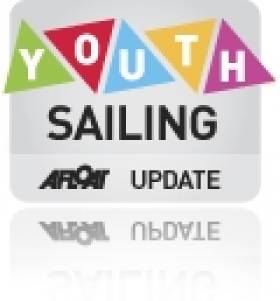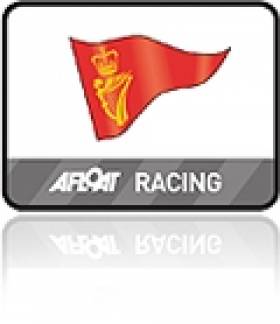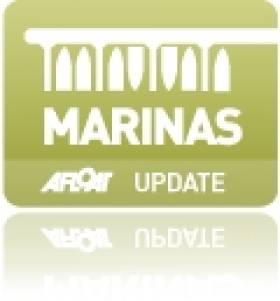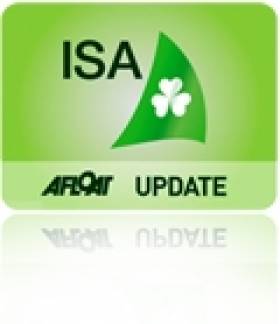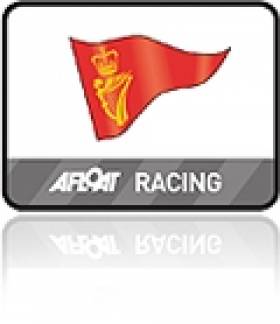Displaying items by tag: Royal Cork Yacht Club
Youth Sailing Champions Are Saluted at Royal Cork Yacht Club
#youthsailing – Sunday turned out to be a miserable morning with winds gusting 30 knots at Roches Point and resulted in Principal Race Officer Peter Crowley cancelling all racing for the four youth sailing Classes writes Claire Bateman. Consequently, prize giving for these fleets was moved forward to 1.30 pm and facilitated an early journey home for the competitors.
In the Topper Class Geoff Power of Waterford Harbour Sailing Club took first place with a four point lead, while Luke McElwaine of Newcastle Yacht Club/Carlingford Lough Yacht Club came in second, only one point ahead of Tom Keal of Royal Cork Yacht Club in third place. First female Topper sailor was Caoimhe Foster of the host club, who came in fourth overall, only one point behind third place. The Toppers only managed four races over all in the event due to adverse weather. These results will be part of the basis for choice to compete for the Topper Summer Squad and the final decision on the full squad will be made in the coming weeks.
In the Laser 4.7 class the winning sailor was Henry Higgins of Royal St George Yacht Club and overall second placed sailor and winning female sailor was Rebecca O'Shaughnessey of Royal Cork Yacht Club with third place going to Conor Quinn of Carlingford Lough Yacht Club. This is an indicator event for the 4.7 ISA squad for the summer, along with other event results.
The performance of the Laser Radial girls at this event has to be noted, with five girls in the top ten and Erica Ruigrok of Rush Sailing Club coming in at third place, also giving her the first female result. Conor O'Beirne gave the most consistent performance over the nine races and gained first place. Second place went to Cian Byrne of Royal Cork Yacht Club who showed good local knowledge of winds and tides and used them to his advantage.
There was an extremely tight battle for first place in the 420s between Douglas Elmes and Colin O'Sullivan, of Royal Cork Yacht Club and Howth Yacht Club, and Peter McCann and Harry Whitaker, also Royal Cork, who took the overall prize. James McCann also Royal Cork, with Bill Staunton of Skerries Yacht Club as crew, was hot on the tail of his elder brother throughout the event and finished in third place. Lizzy McDowell and Anna O'Regan of Malahide Yacht Club were not far behind and took fourth place and first female position.
Meanwhile the wind had abated and shifted to the North and enabled racing to commence for the hardy optimists and this was particularly important in that places were up for grabs for the Worlds Team, the European Team and a Development Squad. Two races were sailed giving them a total of thirteen races over the event.
Top scoring Optimist in the Trials was Micháel Ó Suilleabháin KYC followed by Harry Bell of HYC second, followed by Gemma McDowell of MYC in third place.

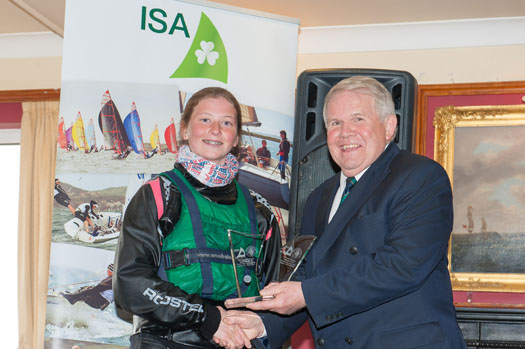
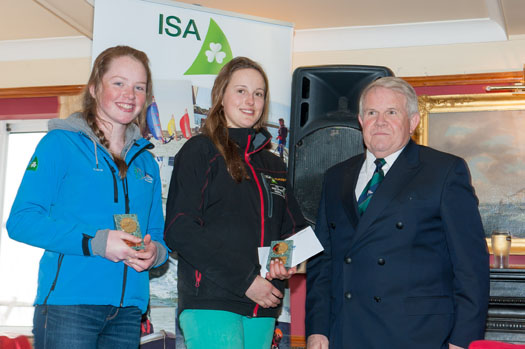
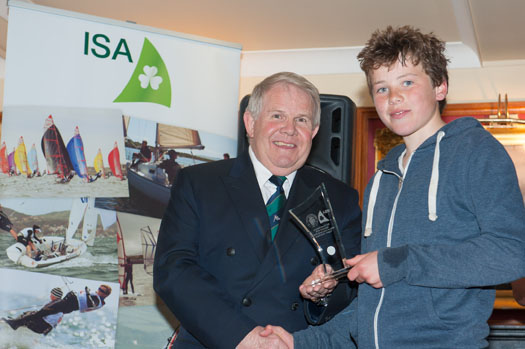
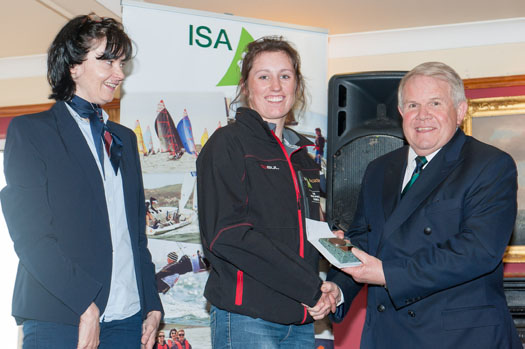
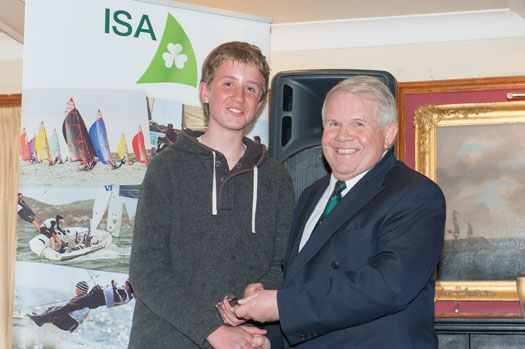

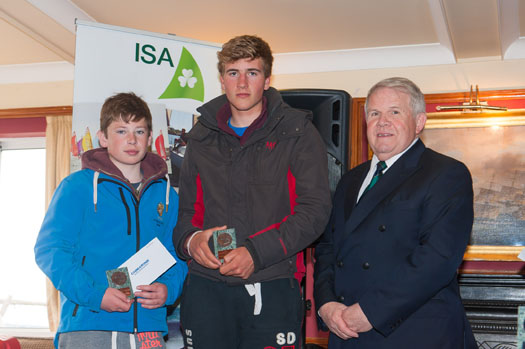
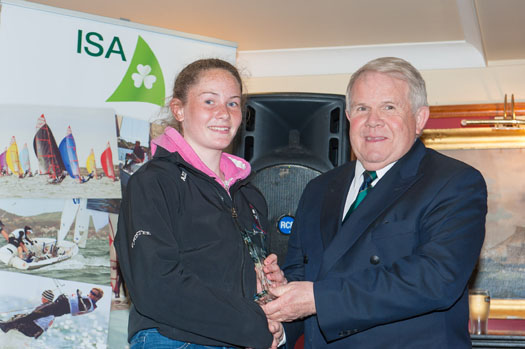
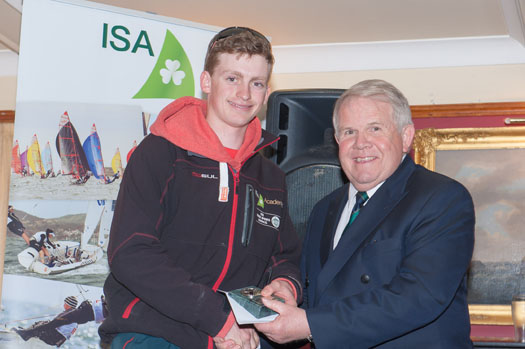

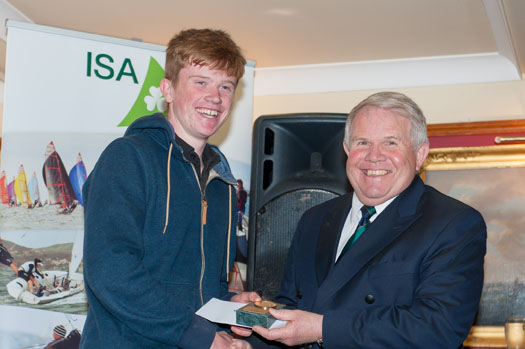
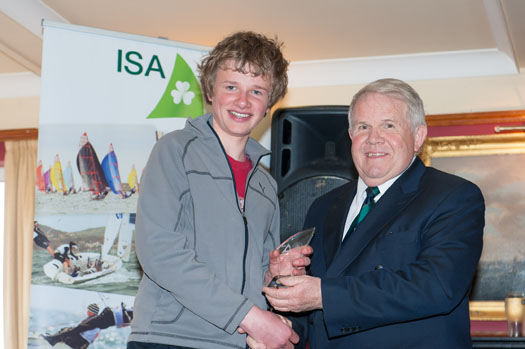
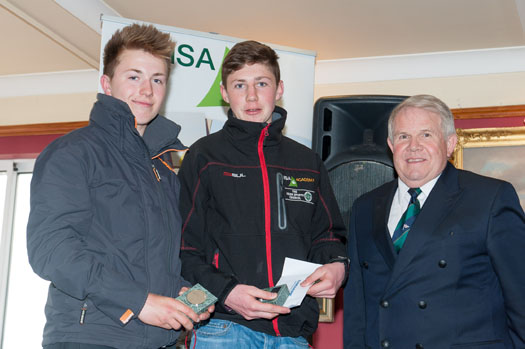
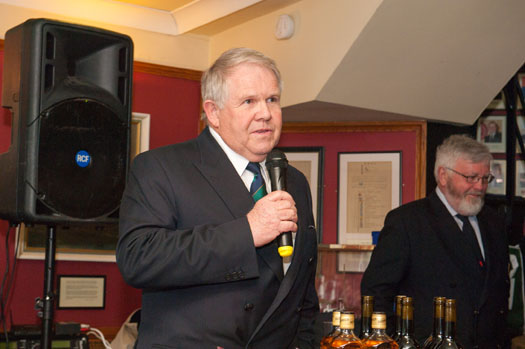
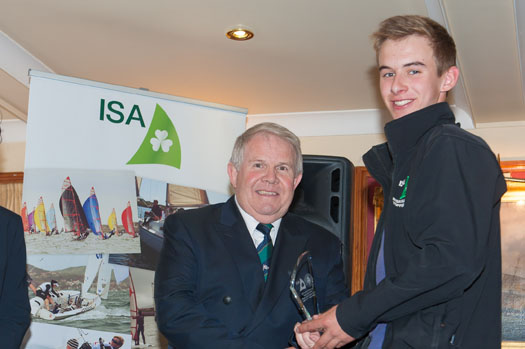

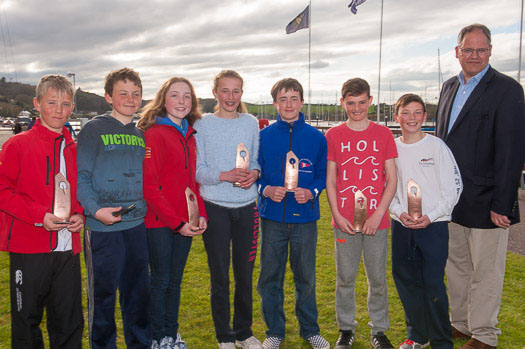

Radials & 420s Start Youth Nationals At Royal Cork
#youthnationals – Today saw the first day of racing at the ISA Pathway Trials and Youth Sailing Championships at the Royal Cork Yacht Club writes Claire Bateman. Today's fleets were Laser Radials and 420s. The Principal Race Officer was Alan Crosbie. The morning turned out to be foggy but there was a light south easterly breeze and the sun made an appearance making it into a pleasant day but still retaining some heat haze.
During the day the wind strengthened slightly and went more into the east with Alan Crosbie weaving his magic by sailing the 420s on the outer loop of a triangular course while the Radials sailed on the inner loop. For the next three days the fleets will be joined by the Toppers and the Laser 4.7s.
Meanwhile, not a mile away on the Curlane Bank, Race Officer Anthony O'Leary was performing his style of magic in enabling the IODAI Optimist Trials also to get in three races. There was no doubt he got the best of the wind from his position as it was somewhat stronger on this course and he got in three fine races for the sixty plus competitors and the races were over forty minutes each for two of them with the third being over fifty minutes.
The IODAI Optimist Trials will run over 4 days from today (Thurs) to Sunday. This is a qualifying event for the Optimist sailors to represent Ireland in 2015 - the top five at Optimist Worlds in Wales, next seven at Optimist Europeans in Poland and a number of sailors chosen for a development team that will sail at the French Nationals.
The 420s and Laser Radials are competing in the ISA Youth Pathway Nationals from today (Thursday,) while the Toppers and Laser 4.7s will compete from tomorrow, Friday to Sunday. Normally this is a qualifying event for the Youth Worlds, which are usually in the summer, but the 2015 Youth Worlds are in Malaysia in December which is a little too far away. Still an important event for all the classes as the Lasers compete for the honour of ISA Youth Pathway Nationals Champion, the 420 sailors are qualifying for the Junior Europeans and Worlds, while the Toppers are qualifying for the ISA Summer squads which will build up their skills for the Topper Worlds in Lake Garda. This is an open event for ALL Topper, 420, Laser 4.7 and Laser Radial sailors, which means the young sailors did not have to qualify to enter and it gives ALL sailors a chance to compete against each other on an even playing field.
All in all an excellent, if somewhat long day for the youth competitors but obviously scintillating and provided for plenty of chatter and camaraderie when coming ashore and bringing their boats back to the allotted compounds for each fleet.
Racing continues tomorrow (Friday).
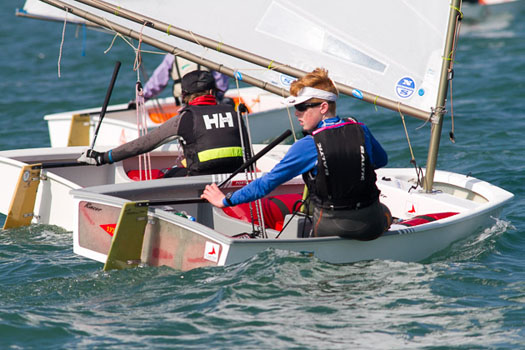

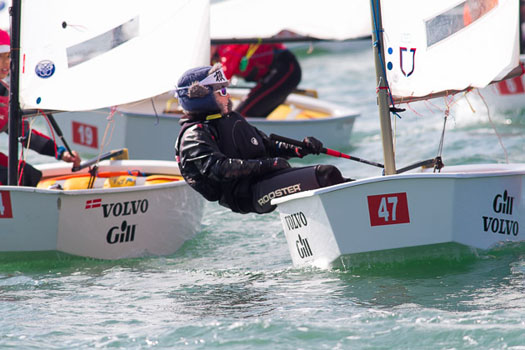

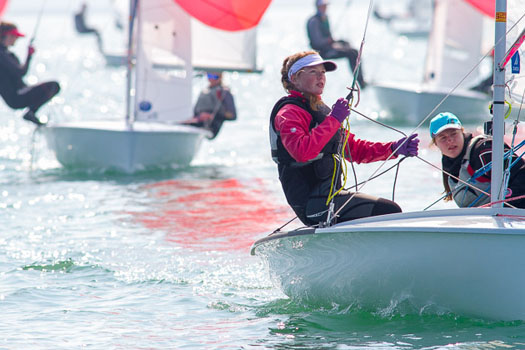
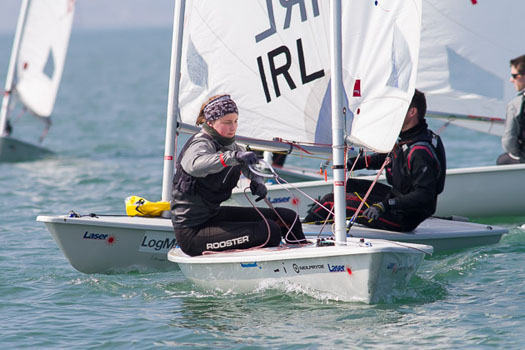
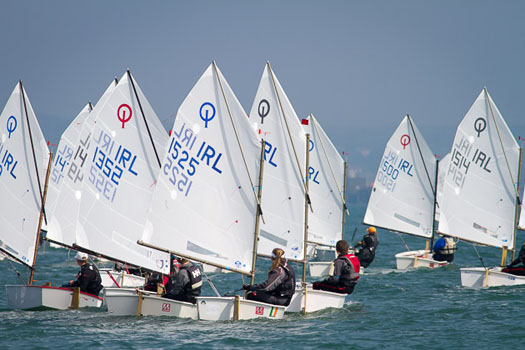
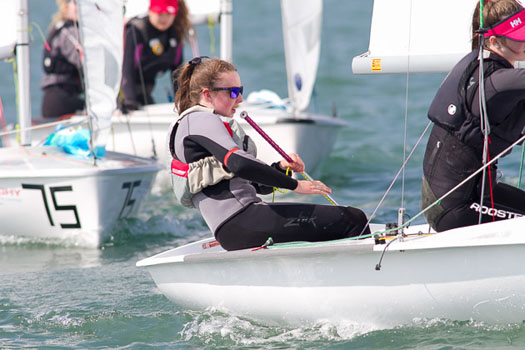

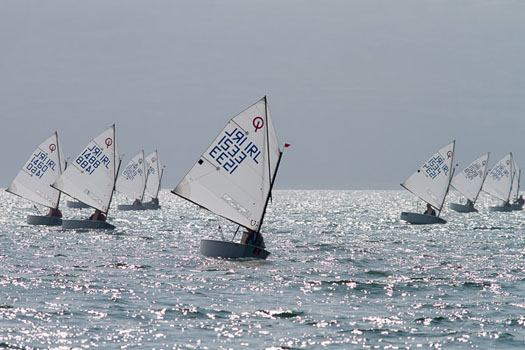
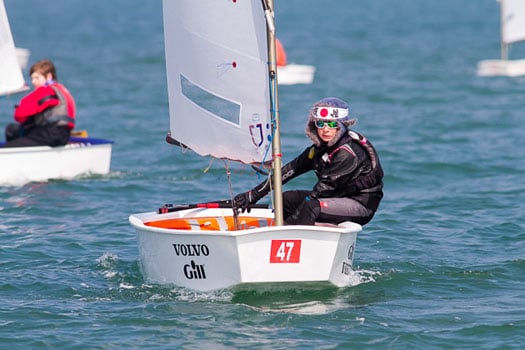
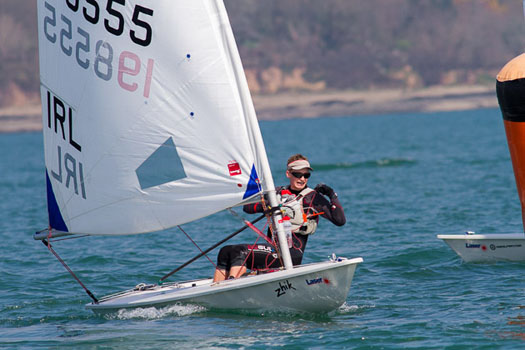
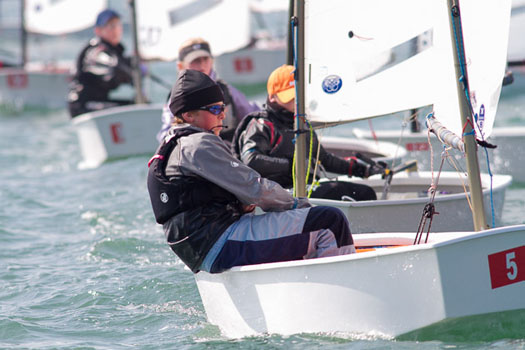
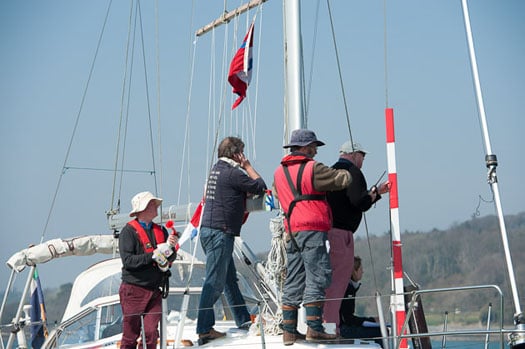


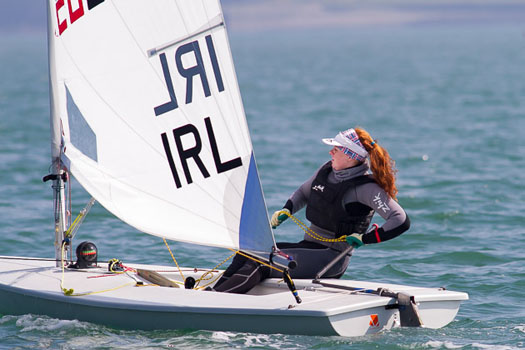
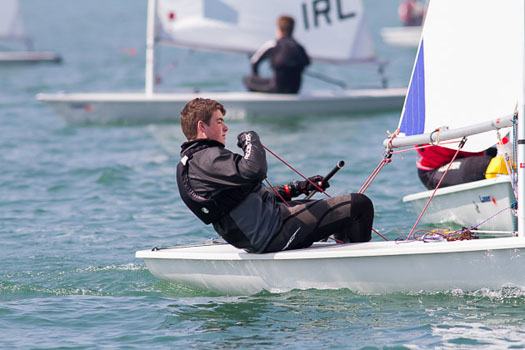
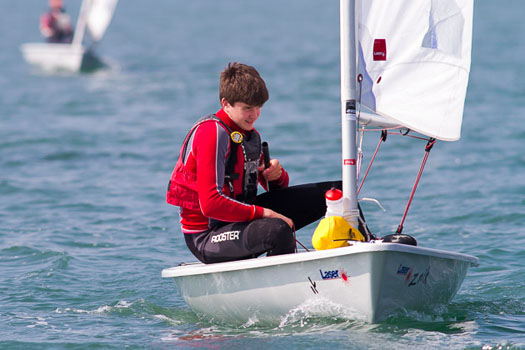
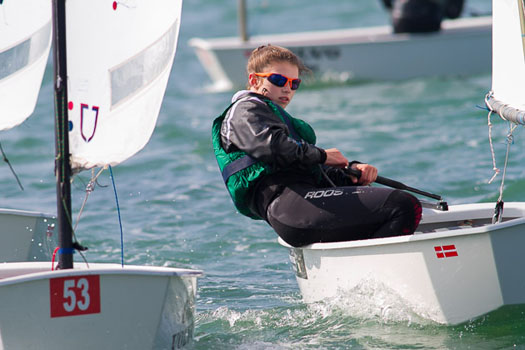
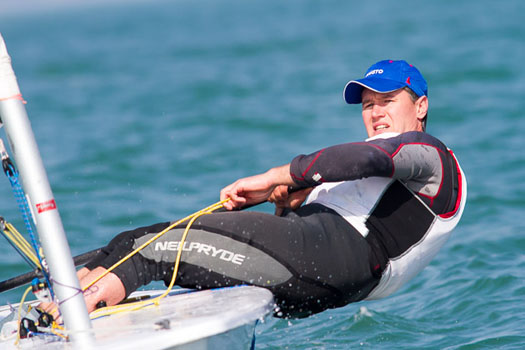
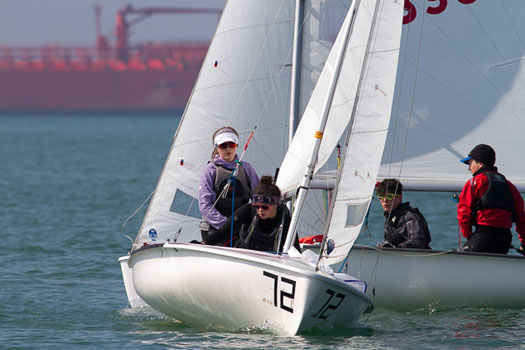
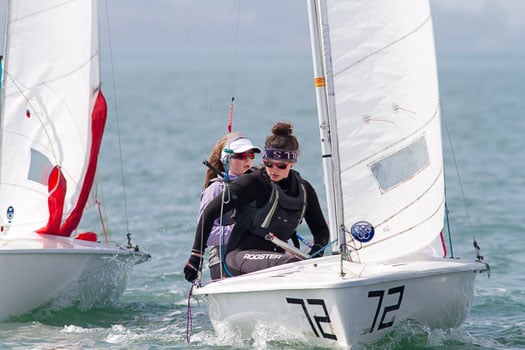
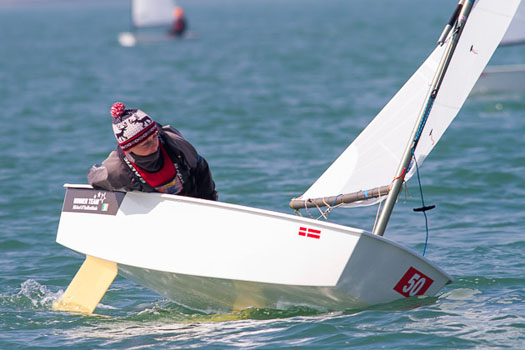

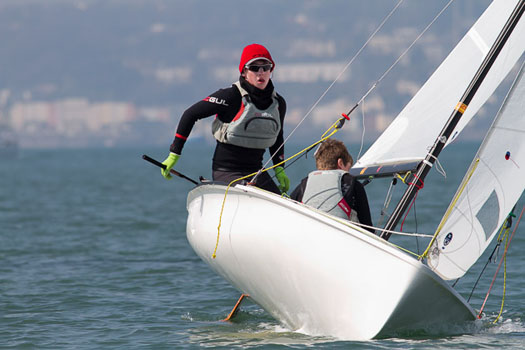

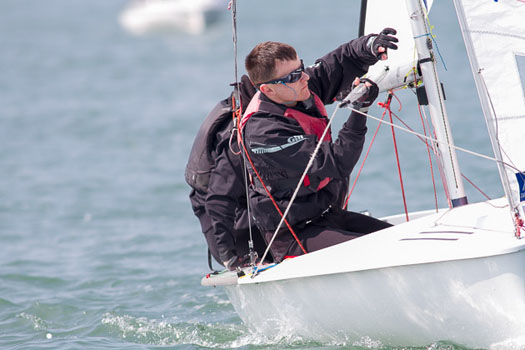
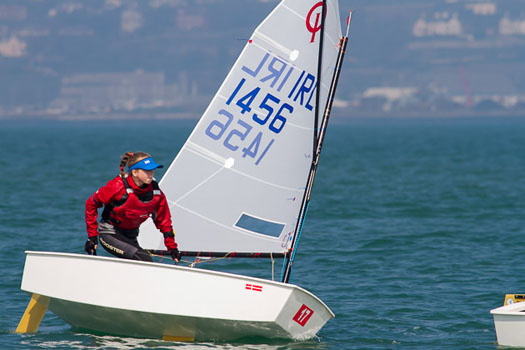
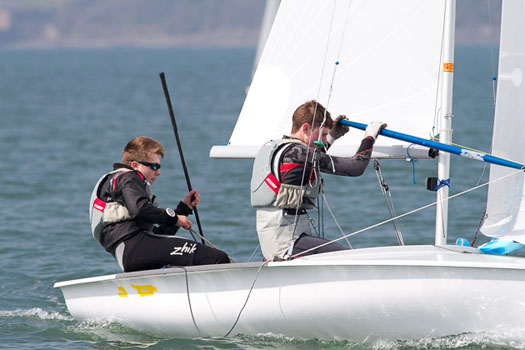



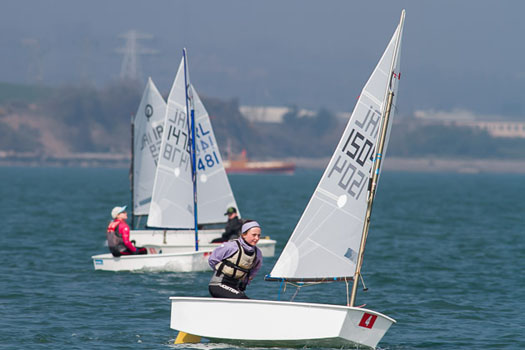
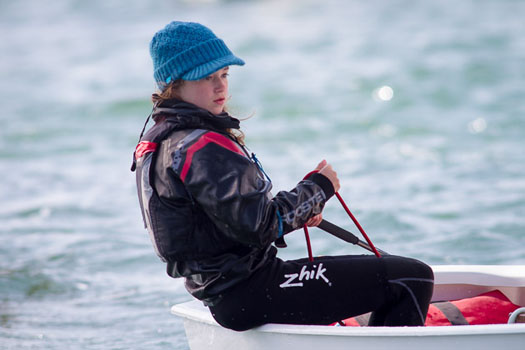
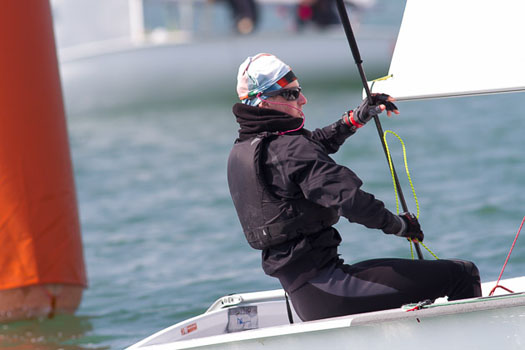
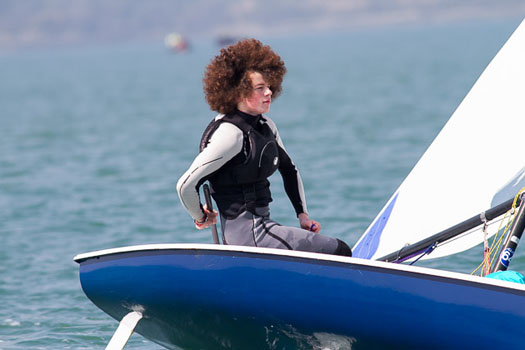
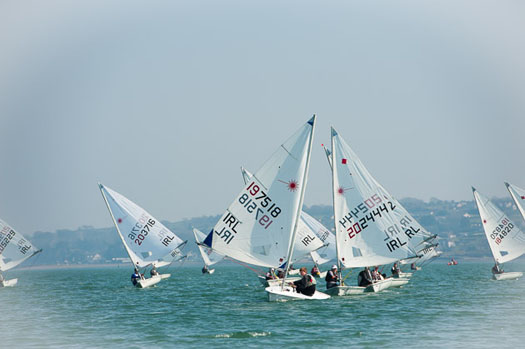

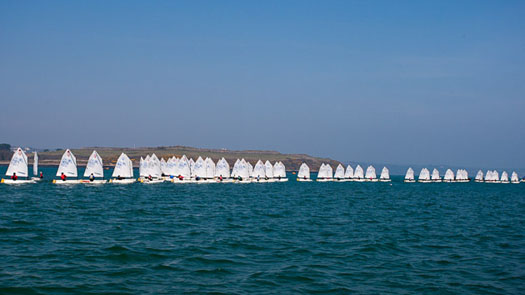
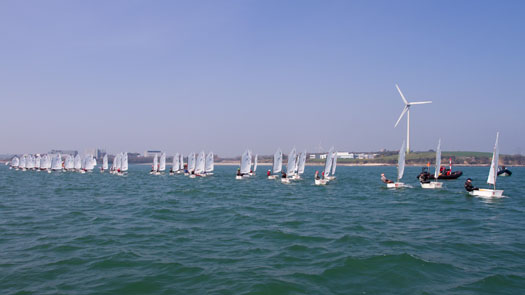
#youthsailing – The Youth Sailing Nationals for Topper, 420, Laser 4.7 and Laser Radial will be hosted by Royal Cork Yacht Club from tomorrow, Thursday 9th to Sunday 12th April 2015. This is an open event for all sailors in these classes writes Claire Bateman.
Today at the RCYC the air was filled with excited chatter and greeting of friends arriving from all over Ireland. Conditions were ideal with bright sunshine and sailors quickly got down to the last minute preparations and checking of their gear. The Optimists were weighed and they had their sails stamped.
The ISA Youth Pathway Nationals will be the selection trials (or part of) for National squads and an indicator (amongst other events) for the Academy. Classes sailing will be 420, Laser Radial, Laser 4.7 and Topper. The IODAI 2015 Optimist Trials will be held in conjunction with, but sailed on a separate course from the Championships. There will not be an Optimist fleet in the ISA Youth National Championships 2015. Tomorrow Thursday the Laser Radials and 420s will commence racing. Tomorrow will also see the beginning of the Optimist four day IODAI Trials with Anthony O'Leary Afloat Sailor of the Year as Race Officer, and Friday will see the commencement of racing for the Topper and Laser 4.7 fleets.
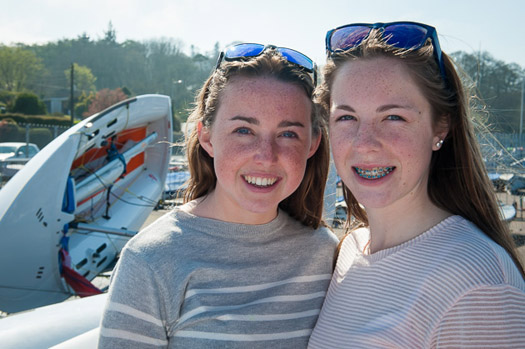

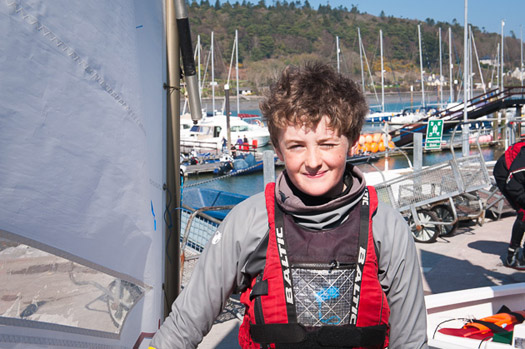

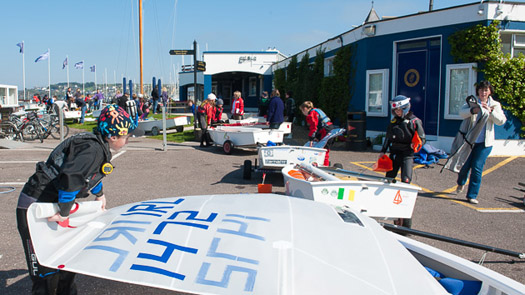
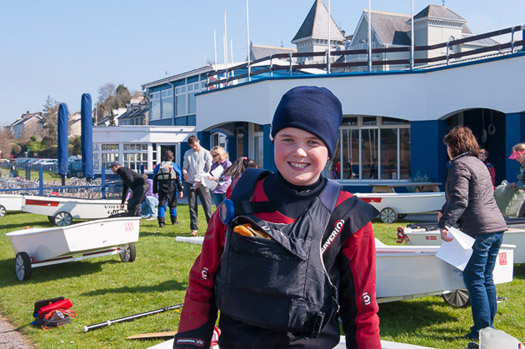
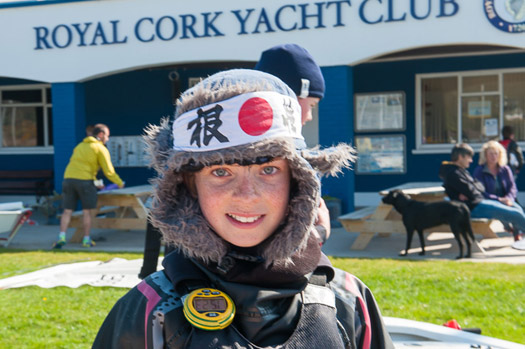
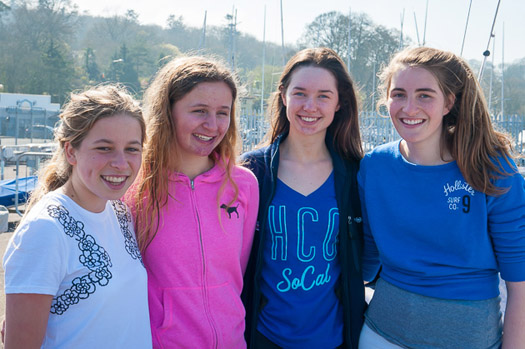
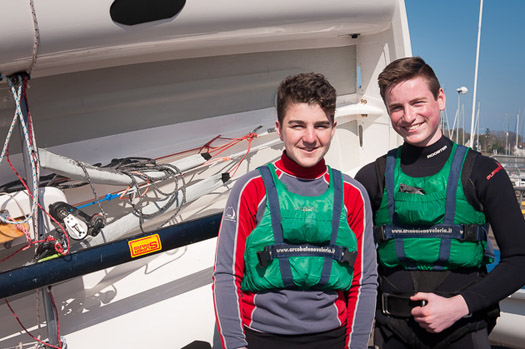
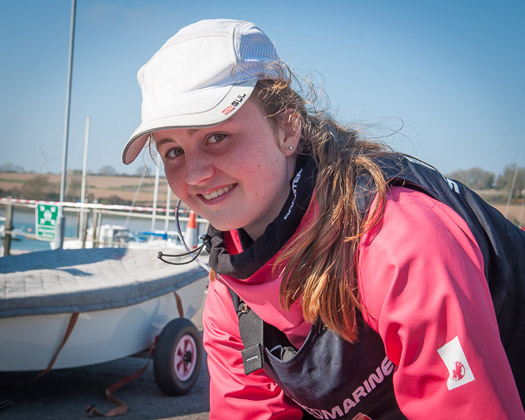
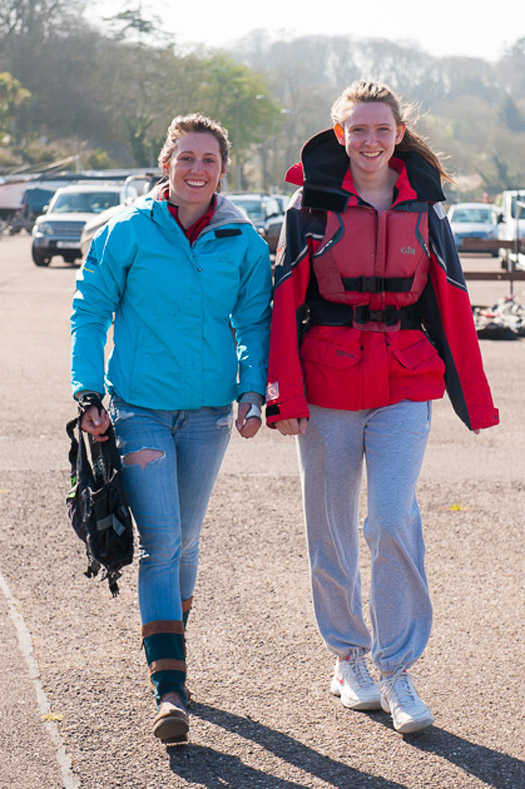
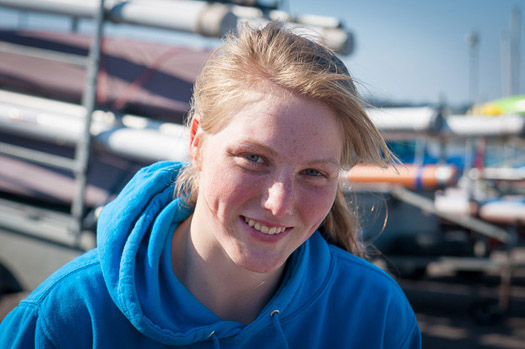

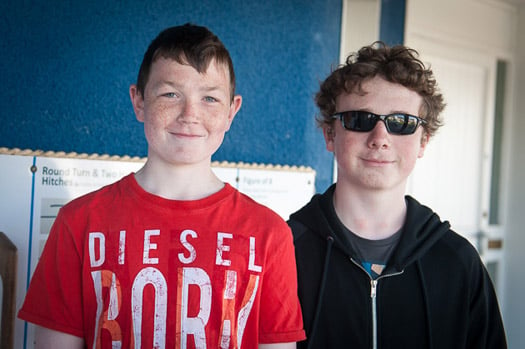
National 18s Take Dinghy Racing Class Onto A New Plane
#national18 – There are some special dinghy classes. There are some very special dinghy classes. And then there are the National 18s.
You can see any number of reasons why this unique class, celebrating its 80th birthday in just three years time, is in a league of its own. A three-man boat with one of the crew on a trapeze, its crewing set–up requires a level of sociability which is further emphasised ashore, where their après sailing is the stuff of legend.
At all the centres where it is sailed, and at places upon which the National 18s have descended for a championship, we know they've left behind a formidable reputation for determined but good humoured conviviality, combined with great sportsmanship.
Yet while it is easy to understand the class's popularity among its adherents when you see them in high spirits as a group, there's no getting away from the fact that in today's dinghy terms, 18ft is a lot of boat. The mood of the National 18s may often seem light-hearted. But keeping one of these boats in prime condition and well crewed is not something for the casually-interested.
It requires real commitment, yet that is something which National 18 sailors seem to have in spades. And now the class has taken on a new lease of life with the development of a fresh take on the National 18 parameters by legendary designer Phil Morrison. But rather than being launched as a commercial venture, the new boat is being developed from within class resources, which has involved several imaginative fund-raising ventures. W M Nixon found himself being drawn into one of them.
It's official, The Cork Harbour National 18 Class are brilliantly capable of running a booze-up in a distillery. And just to make it even more challenging for their supportive members and many friends, they ran this particular fund-raiser for the new Phil Morrison boat in the Jameson Distillery in Midleton in East Cork on the first Saturday night of Lent.
Of course, like all Ireland on St Patrick's Day three weeks later, they got a special dispensation for the partying to continue unhindered by thoughts of Lenten piety. There was plenty of time for that next morning. But meanwhile, right there in the heritage and high tech splendour of the Midleton facility where tradition and new science are dynamically allied, the National 18 crews went at it good-oh, and the class's Development Fund was greatly enhanced.
In fact, I'm told the financial targets were comfortably exceeded, but as Class President Dom Long and the ever-energetic Tom Dwyer didn't tell us the targets in the first place, we'll happily take their word for it. All I know is that it was one helluva night, and only the National 18s could have done it.

Let's party! Colman Garvey's vintage National 18 welcomes guests to the Midleton Distillery for yet another event in a series of fund-raisers which have supported the development of the new boat from within class resources. Photo: W M Nixon
It's a class which – thanks to being a restricted design rather than a hidebound one-design – is able to wallow happily in its history as it thrusts towards new designs which keep up the spirits of its established sharpest sailors, while also encourage the vital new blood.
So how did it all come about? Well, thanks to a prodigious book written by Brian Wolfe of the boat's history, published in 2013 to mark the class's 75th Anniversary, we get some idea of the inevitable complexity of the story. The class started in 1938 in the Thames Estuary where there'd been several local one design or restricted "large dinghy" classes around the 18ft mark and soon – under a National Class imprimatur from the Yacht Racing Association – it spread to several other centres.
Needless to say, World War II from 1939 to 1945 brought any further growth and most sailing activity to a halt, but by 1947 things were looking up again, and in the straitened post war circumstances, the National 18 found its niche. Back in 1938, Yachting World magazine had sponsored a design to the class's rules by Uffa Fox, and that became the clinker-built Uffa Ace, which continued to be the backbone of the class for many years after the war.
It was Whitstable in the far east of Kent which produced most of the initial impetus for the class, and local builders Anderson, Rigden & Perkins made a speciality of it. In fact, ARP-built Uffa Aces were soon virtually the definitive National 18. Yet ironically we cannot confirm at the moment if the oldest National 18 still sailing – Richard Stirrup's 1938-vintage Tinkerbelle which races with the classics divison at Bosham SC on Chichester Harbour – is an ARP boat.
It's ironic because Tinkerbelle's first home port was Howth. It wasn't until I was writing the history of Howth YC for its Centenary twenty years ago that awareness surfaced that there'd been the nucleus of a National 18 class in Howth in 1938.
There were just three boats – John Masser's Wendy number 14, Tinkerbelle number 15, and Fergus O'Kelly & Pat Byrne's Setanta, number 16.

Tinkerbelle (15) being sailed by Aideen Stokes in 1939, with John Masser's Nat 18 Wendy (later Colleen II) astern, and the Corbett family's Essex OD Cinders abeam.
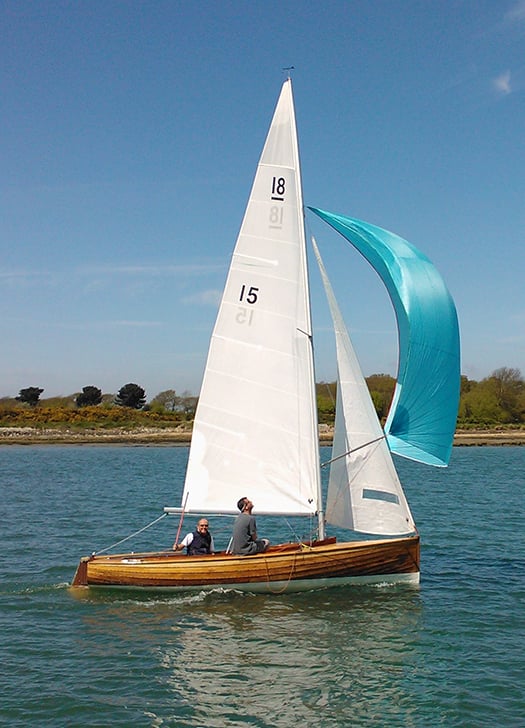
Tinkerbelle as she is today, the oldest National 18 still sailing. Her home port is Bosham on Chichester Harbour. Photo courtesy Richard Stirrup
Tinkerbelle seems to have been owned by a syndicate in which the Stokes family was much involved, though in the class history her earliest owner is listed as Bobby Mooney, son of the renowned Billy Mooney of Aideen fame. However, around Howth, Tinkerbelle was best remembered for being raced with considerable panache by a non-owner, Norman Wilkinson.
But when Norman returned from war service in 1946 determined to sail just as much as humanly possible, he found that the National 18s had faded away, and the only way he could get regular racing was by buying the 1898-built Howth 17 Leila, which he duly raced with frequent success right up to the end of his long life in 1998, by which time Leila was a hundred.
It's intriguing to think that, with one or two twists of fate in Howth, Norman Wilkinson might have been renowned as a star of the National 18s taking on the likes of class legends such as Somers Payne and Charlie Dwyer of Cork, where the class – having started with just two ARP boats in1939 - held fire for a while, but got going big time in the late 1940s and early '50s with several builders all round Cork Harbour creating them in local workshops.
That was one of the attractions of the National 18s. They were big enough to appeal to people who didn't fancy skittish little dinghies, yet they were small enough to be constructed by artisan boatbuilders who could produce lovely boats. But the owners – having laid out what were considerable sums of money at a time when Ireland seemed to be in a state of permanent economic depression – were disinclined to go the final stage of having the boats properly measured and registered with the class. This caused increasing problems, ultimately solved by a high level of diplomacy as the National 18s' popularity grew, and the opportunities arose for the Cork boats to go across the water to race in big-fleet competitions.
At one stage, class numbers were so healthy at many centres that in Britain they had Northern and Southern Championships, reflecting the primitive state of road movement of boats. Dinghy road trailers – particularly for hefty big 18-footers – were still in their infancy, so all sorts of ingenious methods were used to get boats to distant events, with a Whitstable boat on at least one occasion getting to Cork as deck cargo aboard a Coast Lines vessel on its regular route which took in Rochester in Kent and eventually Cork among several ports.

The National 18s in their classic prime, with immaculately vanished clinker-built hulls, and setting lovingly-cared-for cotton sails. Here, Crosshaven's greatest National 18 sailor Somers Payne (Melody, 206) is being pursued by Alan Wolfe in Stardust 63), while up ahead Charlie Dwyer with Mystic (208) is doing a horizon job, with the legendary Leo Flanagan of Skerries lying second at the helm of Fingal. The photo was taken during a Dinghy Week at Baltimore, and it is memories like this which inspired Brian Wolfe (son of Stardust's owner-skipper) to undertake the mammoth task of collating and writing the class's history.
In Ireland, centres which saw interest in the National 18s included Dunmore East, Clontarf and Portrush, but as Dun Laoghaire was committed to the 17ft Mermaid, the only place on the East Coast with really significant National 18s numbers was Skerries, where the incredible Leo Flanagan set the pace driving his Jensen Interceptor ashore, and racing his no-expenses-spared ARP-built National 18 Fingal afloat in somewhat erratic style.
Leo was a ferocious party animal, and when the Skerries and Crosshaven National 18s united in going to the big class championship at Barry in South Wales in the mid 1950s, Leo was very disappointed to discover that, just as the party was really getting going, the club barman had every intention of closing at closing time. The very idea....Leo solved the problem by buying the entire bar for cash on the spot.
As far as Leo was concerned, sailing was for parties, so when he heard of the highly-organised Irish Olympic campaign towards the 1960 Olympics in Rome, he got himself to Rome, as Olympic sailing promised Olympian parties. To his distress, he was ordered out of the Olympic Village by the Irish squad, who wanted no distractions. But to their distress, the bould Leo then turned up next morning for the first day's racing, officially accredited and highly visible in his new role – he had become manager of the Singapore team.
It seems that in a harbourside bar the night before, he'd met the helmsman of the Singapore Olympic Dragon (as it happened, the only Dragon in Singapore), who was racing in the Olympics as a personal venture. As the biggest rubber concessionaire in Malaya, he could well afford to do so. But this meant he was also Team Manager, and when Leo met him, the Singapore skipper was much upset, because with his sailing duties and need to get a good night's sleep before each day's racing, he was simply unable to take up all the official invitations which any Olympic Team Manager received.
He felt he was badly offending his hosts, and completely failing the Singapore sailing community So Leo, out of sheer kindness, agreed to be the Singapore Olympic Sailing Team Manager, giving selflessly of his time, energy and great wit in the front line at all the best and most fashionable parties throughout the 1960 Olympic Regatta.
All of which has little enough direct connection with the story of the National 18s, but it gives you some idea of the style of the people who have been involved in a long tale which will soon have been going on for eighty years. Yet beyond the parties and the many scrapes they got into, there was also much serious sailing and boat development going on, for although the Uffa Ace was the most numerous design in the growing fleet, anyone could have a go provided they fitted within the class rules.
But by the mid-1960s, it was clear that the traditional concept of a clinker-built National 18 was losing its appeal, and in 1968 the Class Association asked Ian Proctor to design a National 18 to be built as a smooth-hulled fibreglass series-produced boat, with bare hulls to be available for owners who wished to finish the boats themselves.
However, being mindful of keeping existing wooden boats competitive, the new boats were built much heavier than their glassfibre construction really required. Yet they looked good, and the first one Genevieve (266) was delivered to class stalwart Murray Vines, who sailed with the Tamesis Club on the Thames. There, the river may have been pretty, but it was so narrow that when the Tamesis people secured a major championship, they took their entire race management team down to the coast to attractive sea venues where the National 18s could do their thing with style and space.
That said, it was far from style and space they were reared. Murray Vines' son Jeremy – who is proud owner of the very first production version of the Phil Morrison Odyssey design which the class has been developing for the past two years – recalls his own earliest experience of championship competition with the National 18s in 1949 aged 11. He and his brother crewed for their father in 18/51 in a championship on the Medway in Kent, and they lived afloat on the boat, for in those days many National 18s lay to moorings.
Perhaps as a reward, the father built the two young Vines brothers their own International Cadet Dinghy the following winter. But Jeremy has remained loyal to the National 18 class to the point of being the pioneering owner for the new version of the design despite being at a certain age which you can work out yourself from that data given for the Medway in 1949. That said, he has given himself more space for his sailing as he has moved his base from Tamesis to Lymington, and in addition to the National 18, he cruises and races the Dufour 34 Pickle, a sister-ship of Neil Hegarty's award-winning Shelduck which featured in this column a week ago.
That the new wave of glassfibre 18s was not going to outclass the existing boats was forcefully demonstrated in 1970, when the class held its first combined all-British & Irish Championship in Cowes, after twenty years of separate Northern and Southern events. Despite the new glassfibre boats, the classics from Cork Harbour – where they'd been in the midst of celebrating the Quarter Millennium of the Royal Cork YC - were dominant, with Somers Payne right on top of his form sailing Melody (206) to win going away, notching only 1.5 points to second-placed clubmate Dougie Deane on 14.
Cork Harbour boats took the first six places in a crack fleet of thirty-one of all the best from every top National 18 centre, and the spirit of it all was best captured by the Thames Challenge Cup for a family crew going to Royal Cork's Dwyer family – Charlie and his sons Michael and a very young Tom – who placed sixth in Mystic.
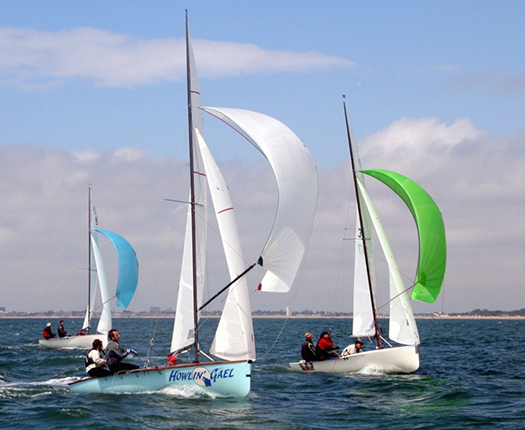
The furthest flung fleet is at Findhorn in northeast Scotland, but the huge distance involved doesn't stop Royal Findhorn YC boats competing with the rest of the class. This is top RFYC helm Stuart Urquhart's Howlin Gael racing in the Solent, and every so often the class – including those from Cork – make the long trek to Finhorn for an annual championship.
However, in terms of championship success the movement towards overall victory by glassfibre boats had begun, and 1977 saw the last championship win by a wooden boat, with Mike Kneale's Maid Mary (183) from the Port St Mary fleet in the Isle of Man. This was a hotbed of National18 racing for a couple of decades, and after Mike had completely renovated the 23-year-old formerly only so-so Maid Mary, he clinched the 1977 title at Findhorn in northeast Scotland "just before you get to Norway", as I was told in Midleton last month. There, the Royal Findhorn YC is a byword for warm hospitality ashore and hot sport afloat, but despite a strong challenge by a formidable Cork contingent, the Manxmen won out.
But having done his duty by the classic wooden boats, for 1979 Mike Kneale and his team took a different tack – they commissioned a new National 18 design from ace ideas man Jonathan Hudson, which they composite-built around Airex foam whose use other Manx DIY boat builders such as Nick Keig had been deploying for long-distance multi-hulls.

The Airex boat....Mike Kneale's innovative Woodstock on trials off Port St Mary in the Isle of Man in 1979.
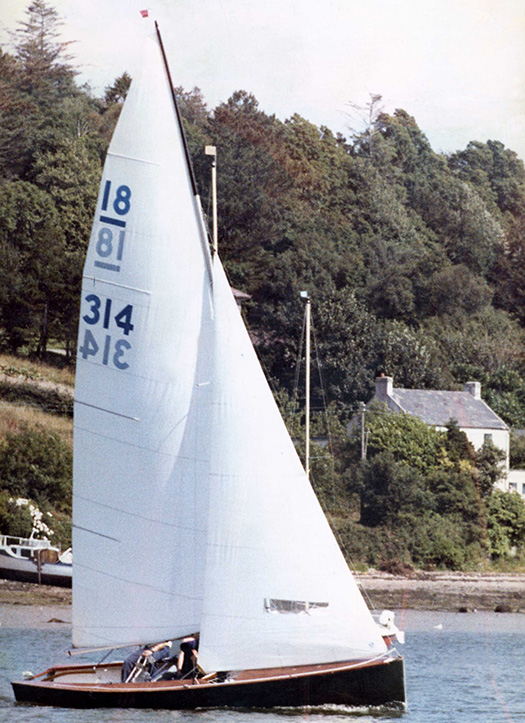
Woodstock from the Isle of Man sails back into Crosshaven in 1979 with all the look of a boat which has just won the championship.
Despite – or maybe because of – her composite materials, the new boat was called Woodstock. And as Brian Wolfe's history of the class recalls, when she appeared for the well-supported 1979 championship in Crosshaven, "there was much debate", not un-related to the fact that Mike and his crew of Rick Tomlinson and Ross Thomas swept the board, taking the championship for Mike's fourth time in a clean sweep with the top boat from the home Cork Harbour fleet being Albert Muckley's Eastern Promise (323) in second overall for East Ferry SC.
So where was Somers Payne? Well, after dominating the national championship leaderboards since 1958 with the wooden Melody, in 1979 Somers was making his first foray into campaigning a glassfibre boat, and while he may have been third, the writing was on the wall, and the class was moving to class.
And there was new life at Royal Cork. The Royal Cork YC's National 18s were having one of their periodic re-births, and while Woodstock may have won the title, her designer reckoned it was only by extra skill that they stayed ahead of a new wave of young talents whose helming skills had been honed in events like the Admiral's Cup and many national and international championships in all sorts of boats. Their zest for international competition was buoyed up by the knowledge that, back home in Crosser, they had ready-to-go racing in the National 18s which was not only great sport, but somehow much more fun than sailing in other boats.
This continued level of enthusiasm at all ages meant that when the National 18 pace showed any signs of slackening, the Cork Harbour division could be relied on to get things up and moving again. Thus when the changeover to glassfibre had become complete at the front of the fleet, with many other owners happy to race their vintage boats in a classics division, some of the Corkmen questioned why new glasfibre boats were still being built overweight in order not to out-perform boats which now saw themselves as a different part of the class in any case.
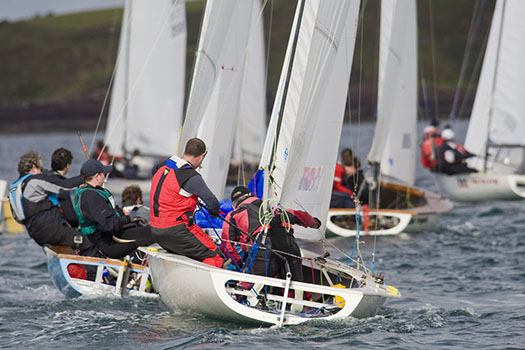
The National 18 fleet in Cork Harbour was mustering serious numbers with the lighter GRP boats from O'Sullivan's of Tralee. Photo: Bob Bateman
So the Crosshaven people got the moulds from England, and encouraged the moving of them to O'Sullivan's Marine in Tralee (incidentlally just about as far west on land as you can get from Whitstable in Kent), where they were used to build a whole new wave of lighter boats which became the National 18 class as most of us have known it until this year. Now, the new moves into the Phil Morrison boat are providing a fresh direction for a class which nevertheless takes careful steps to ensure that older boats have their place in the sun with a chance of realistic racing against similar craft.
Although Jeremy Vines of Tamesis and Lymington is the owner of the first of the new boats (she's number 401, and is called Hurricane in honour of the very first National 18 built by Anderson, Rigden and perkins in Whitstable in 1938), he is untinting in his praise for the energy and vision of the Cork harbour division of the class in having the idea and then promoting the new Phil Morrison boat, and he makes a particular point of applauding the very tangible support which has been given to the project by the Royal Cork Yacht Club.
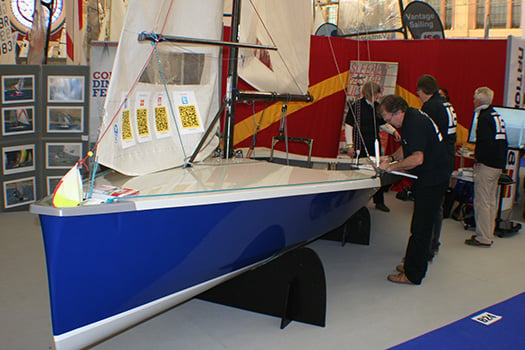
Into the blue.....Hurricane (number 406) is unveiled a fortnight ago at the Dinghy Show.
It's almost unfair, in such a community-based grass roots project, to single out anyone for special praise, but I got the feeling that folk like Colin Chapman, Dom Long and Tom Dwyer have been right there in the thick of it from the beginning.
The prototype having been tested and approved every which way, the moulds were made and the first dark blue hull emerged early in the New Year in one of the workshops which Rob White runs at White Formula Boats at Brightlingsea in Essex. So having been built at Tralee on the shores of the Atlantic for more than a decade, National 18 production is now back on the shores of the North Sea, but the spirit of the class at every location, regardless of where it might be, seems keener than ever.
The first of the new boats - of which sixteen have now been ordered – was Jeremy Vines' Hurricane, number 406, which was unveiled at the recent Dinghy Show in London. For a new generation which has been raised on the Phil Morrison-designed RS 200, this latest variant on the continuing National 18 story will speak volumes, and with eloquence. But it says everything about the spirit of this exceptional class that she rings a bell with seasoned National 18 sailors too.

The gang's all here. The new boat celebrated at the Dinghy Show with a group including many of those actively involved in its development, notably Colin Chapman, Tom Dwyer, Dom Long and Jeremy Vines.
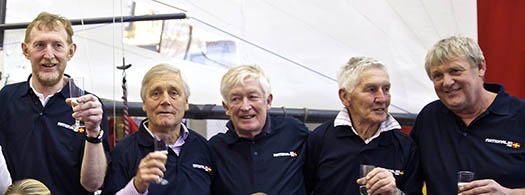
The movers and shakers are (left to right) Tom Dwyer of the Cork Harbour National 18s, designer Phil Morrison, Cork Harbour Class President Dom Long, Jeremy Vines (owner of the first boat to the new Morrison design), and Rob White of White Formula Boats
O'Leary Seventh in Viper Class At Bacardi Miami Sailing Week
#royalcork – At Bacardi Miami Sailing Week, Royal Cork's Anthony O'Leary – who was crowned Afloat's Sailor of the Year on Friday – has finished seventh overall in the 32-boat Viper fleet. Racing with Howth's Dan O'Grady and Cork clubmate Tom Durcan, the sole Irish trio's best individual result was a fourth which they achieved twice in races two and six of the nine race series. Full results here.
Canadian Brad Boston on Jackpot took home the win with 22 points followed by Peter Beardsley (24 points) and Geoffrey Ewenson (26 points) both from the United States. "Perfect Miami conditions," said Brad Boston. " Started light, built up after race one and finished good. We sailed all week in just tee shirts, that alone is unbelievable! It came down to the last race in order to decide the series and it was nerve wrecking because at some point we lost track of the situation and we really didn't know where we were in terms of points.
Royal Cork Retains Five Gold Anchor Marina Status
#royalcork – Royal Cork Yacht Club has retained its Five Gold Anchor Marina award as well as an ICOMIA (International Council of Marine Industry Associations) Clean Marina Award.
The Royal Cork became the first Yacht Club in Ireland to be awarded this prestigious title in 2011 and further to a recent inspection, the Club has again retained this status. Ratings range from one to five gold anchors and for the Royal Cork to attain the maximum number of anchors again is a fantastic achievement by all of the Club staff involved.
Preparations for a busy summer of visiting yachts from all corners of the globe and organisation for some of Ireland's most prestigious sailing events are well under way. Gavin Deane, General Manager commented "This year is gearing up to be a busy one for the Club and retaining our Five Gold Anchors was a fantastic way to start 2015. Through our involvement in the Gold Anchor scheme we hope to see an increase in our visitor numbers again this year which is great news for the Club and also for the local economy. In addition to hosting a number of high profile events this year, we hope to expand on our training offering for both children and adults. Last year the Club was awarded the Irish Sailing Association 'Training Centre of the Year' and we have witnessed a significant increase in numbers coming to try sailing for the first time"
Mark Ring, Racing & Marina Co-ordinator at the Royal Cork, who has qualified as a Certified Marina Manager since our last inspection commented "We are delighted to retain the coveted TYHA Five Gold Anchor Award in 2015. This award is very much a team effort and everyone's input is necessary both in preparing for inspection day and maintaining the five Gold Anchor standard, while upholding that essential customer service ethos. There is an enormous sense of pride amongst all of the staff that our members and visitors will receive excellent service and high standards at the Royal Cork Yacht Club under the THYA Five Gold Anchor scheme."
The Gold Anchor award scheme is a voluntary assessment programme focused on customer service and providing Quality Assured Berthing for any boat owner. The scheme is designed for the marina consumer by The Yacht Harbour Association with contribution from the RYA. With 26 years' experience of Gold Anchor standards, this is a point of reference for all boat owners to make an informed decision on where to berth.
Cork Sailors Hear About New ISA Plan For Irish Sailing
#irishsailing – The Irish Sailing Association SRG (Strategic Review Committee) penultimate meeting of the series took place last evening at the Rochestown Park Hotel, Cork and drew an excellent attendance with a large number of representatives from southern clubs and sailing establishments in attendance and sailing instructors were also well represented. Claire Bateman reports.
The meeting was chaired by former RCYC Admiral David O'Brien, Dublin SRG representatives who travelled were Brian Craig and former ISA Presidents Neil Murphy and Roger Bannon, and Harry Hermon of the ISA.
A full copy of the ISA Strategic plan until 2020 can be found here.
The meeting commenced at 7pm with an introduction by David O'Brien followed by Neil Murphy who took the meeting through the Strategic Plan line by line. The attendance had been requested to hold questions until the presentation was complete and this request was duly complied with. The Q & A session began at approximately 8.50pm with the meeting scheduled to finish at 9pm. People had a lot of points to make and the meeting finally concluded at approximately 9.45pm.
It could have been a meeting from some twenty years ago and this was no bad thing. Some very old chestnuts were still being aired along with some new topics and indeed some views being expressed from the top table were still unchanged from former years. As one would expect from the wonderful cruising areas in the south west, cruising got a good airing from several quarters with changes being requested in recognition of the importance of this branch of sailing. Also, the importance of motor boating was raised with the rise in numbers of such craft now being seen and, indeed as pointed out by Vice Admiral John Roche of RCYC, there are now some thirty to forty such boats on the RCYC marina and other speakers pointed out this is reflected in clubs all around the country.
A thorny area drew huge response from the meeting and this was the situation regarding RYA courses. Currently RYA instructors are giving courses in this country and these instructors will in be working here and it was pointed out these courses are fully recognised outside Ireland while the ISA Instructor courses have no such recognition. The question of frequent compulsory revalidation also proved to be a hot topic and one that the Instructors have requested to be looked at. The lack of availability of qualified instructors also came up for discussion. The ISA Pathway also came up for discussion and is another area to be looked at.
The ISA's view on the question of promoting two person boats over single handed dinghies, desirable and all as the idea may be to some people, came into sharp focus in a week where a sell out mid term sail training week for Optimists in Baltimore SC is being attended by 150 Optimist sailors and their families from all corners of Ireland. Indeed, your scribe, residing near the main route to West Cork, could describe the numbers of vehicles travelling west complete with packed roof boxes and trailers piled high with all the gear while the car interiors showed parents, youngsters and in a lot of cases family mutts, all heading to a week of hard training for the enthusiasts and a fun week for the younger family members and hopefully for the parents and indeed for the village of Baltimore. By all accounts this is exactly what is taking place.
There was a view put forward from the top table that an Optimist sailor coming out of the ranks when it was time to move on would have no knowledge of sailing coming out of a "little box of a boat". Here I have to disagree strongly. Now, I am no great Optimist fan but I have watched these sailors and their knowledge of sailing can be quite fantastic and their experience of different sails in knowing what is needed for different weights and conditions is absolutely tremendous. They go to sea in conditions that leave the rest of the fleets high and dry and enjoy themselves experiencing conditions the experienced hardy annuals would baulk at. Pay a visit to the Royal Cork Yacht Club during any school holidays and you will find the Oppie Skippers sailing anything and everything they can get their hands on. They will go out in Topaz, 420's, Fevas, International 14's, Toppers, you name it and they will be found.
They also join the club racing/cruising fleets as crew and can be found doing on board crew tasks on the these boats and will also helm. Where did Sir Ben Ainslie commence his sailing career? In an Optimist of course. Last word on this, on one occasion when the ISA were really pushing two person boats, one in particular, the parents responded by deciding to buy Laser 2's in large numbers against the recommendation of the ISA. A world championship for these boats was held in Crosshaven with large numbers in attendance. Where are they now?
The appreciation for the hard work of the SRG Committee was expressed by all and the members thanked for coming to Cork. The last meeting of the series will be held in Galway and the final item on the SRG agenda for the moment will be to try to ensure the adoption of the SRG Plan. If sailors have strong views to express they should make the effort to be present at the Maldron Hotel, Portlaoise at 11.30am on March 28th. If you are not there you cannot complain afterwards if an item was passed you did not agree with without at least having the chance to express your opinion.
A good humoured meeting at the Rochestown Park Hotel in Cork and devoid of any real controversy.
Just Who Do The Irish Sailing Association Think They Are?
#irishsailing – Ireland's national sailing authority has been going through turbulent times in recent years. With unprecedented expansion of ISA staff numbers as the country revelled in the boom years of the Celtic Tiger, the arrival of the inevitable and abrupt financial downturn found an Association bloated, unfit to cope, and out of touch with ordinary sailors.
High profile events, top level training and international participation had become so dominant in the ISA's range of activities that many of the ordinary sailors of Ireland already felt the Association was no longer relevant to their own low key personal pursuit of friendly sport afloat.
When the crash came, it led to a marked decrease in active sailing numbers as disposable incomes fell away. People focused on keeping their jobs and businesses afloat rather than their boats sailing, while many promising young sailors were forced to emigrate.
This new reality was reflected by the growing disillusion of club officers, who saw their membership subscriptions decreasing even while the ISA – which is largely reliant on subvention from the clubs for its own income – seemed always to be looking for more money. And at the height of the boom years, when all the major clubs had put through significant expenditure in developing their facilities to international standards, the ISA had shown its lack of contact with the reality of club life by proposing its own stand-alone National Sailing Centre in Galway, a facility which would in effect have been run in rivalry to the main clubs. To the mutterings in the grass roots were added the rumblings from above as major clubs threatened to withhold their annual payment to the ISA unless real reform was initiated. W M Nixon takes up the story.
In a classic grass roots revolution, club sailors Norman Lee from Greystones in County Wicklow and Bryan Armstrong from Sligo were at first rebuffed when they tried to voice their concerns about the ISA's increasing irrelevance to the needs of the vast majority of sailing enthusiasts, people at local level who were doing their very best to keep the sport alive through torrid times.
The Irish sailing community now owes these two men and their supporters a debt of gratitude, for they believed in what they were saying and they refused to be turned aside. Eventually, in November 2013 moves were in place to establish a Review Group for the urgent analysis of all ISA activities, and its personnel drew comprehensively on Ireland's remarkable pool of people with hands-on experience of running successful sailing events and organisations.
It was chaired by Brian Craig of Dun Laoghaire who has headed up the organising team on more major and notably successful international sailing events in Dublin Bay than probably anyone else, and its able personnel included two former ISA Presidents - Roger Bannon of Dun Laoghaire and Neil Murphy of Malahide and Howth - who had both been noted for their skill in running a tight ship when they were in charge. With them was highly regarded International Race Officer Jack Roy of Dun Laoghaire, and renowned sailmaker/activist Des McWilliam of Crosshaven, who each year is inevitably seen in busy involvement afloat in more Irish sailing centres - large and small - than anyone else in the boat world.
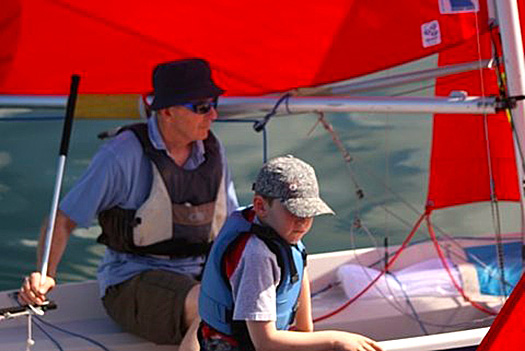
Bryan Amstrong of Sligo on the helm for a Mirror race
Also on board was one of the men from the barricades, Bryan Armstrong of Sligo. His background in a relatively remotely-located club which nevertheless has a long and distinguished sailing history made him uniquely qualified to voice the concerns of the grass roots. And we have to remember that all these people were giving voluntarily and generously of their time to this project in a period when Irish life was largely a matter of just getting through each day, while staying economically afloat was something of an achievement.
Primarily, the Review Group's function was to analyse the Association work on behalf of ordinary club sailors, as it was agreed that the Olympic and High Performance Divisions of the ISA's activities – which receive direct Sports Council grants – were in effect functioning as a different entity.
The Strategic Review Group was still work in progress when the ISA acquired a new President in David Lovegrove in March 2014, but by August the SRG published proposals which led to the setting up of a more formal body, the Planning Group. If this seems like a case of kicking the can down the road, it was anything but - these were people in a hurry, they'd got through the first stage of analysing areas where action was required, now they had to be more structured in coming up with clearcut ideas and concrete proposals.
This new Planning Group, which went into action in early Autumn 2014, was chaired by Neil Murphy, and its members included ISA President David Lovegrove, ISA Board Member Brian Craig, Ruth Ennis, Peter Redden, Sean Craig, and ISA CEO Harry Hermon, with noted Dun Laoghaire events administrator Ciara Dowling to provide administrative support.
They had their draft plan ready by mid-December 2014, and on January 21st 2015 Neil Murphy and his group publicly unveiled their analysis and proposals for the first time at a well-attended and very representative meeting in the Royal St George YC in Dun Laoghaire.
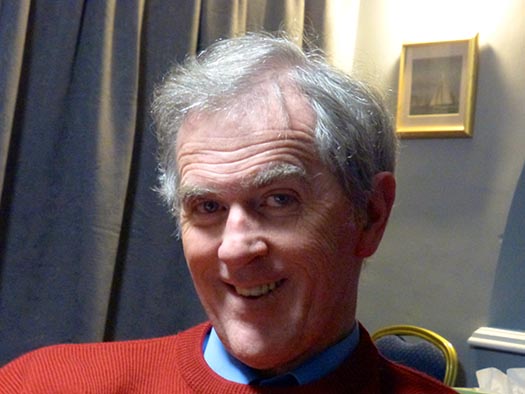 Neil Murphy is a former ISA President who, in addition to extensive experience as a Race Officer, is a typical club sailor, racing a Puppeteer 22 out of Howth. Photo: W M Nixon
Neil Murphy is a former ISA President who, in addition to extensive experience as a Race Officer, is a typical club sailor, racing a Puppeteer 22 out of Howth. Photo: W M Nixon
While those involved in setting the ISA on a healthier course are mostly working on a voluntary basis, it has to be said that the PowerPoint presentation and the printed material was of the highest professional class. In fact, it was much better than many professional shows I've been to, and the level of thought which went into a wide range of questions from the floor answered by Neil Murphy, Brian Craig and David Lovegrove generated a growing level of goodwill which concluded with Norman Lee voicing his congratulations and good wishes for this continuing process in which he and Bryan Armstrong had played such a key role.
So now we move on to the next stage – taking the ideas to the rest of the country. Doubtless you'll have noted the double meaning in titling this piece 'Just Who Do The ISA Think They Are?' In a first interpretation, that question is the one for which, let's hope, we are all now involved in working together in providing and implementing a satisfactory answer.
But equally, as the ISA Road Show gets out of Dublin to take this excellent presentation to a public meeting in Cork next week (it's in the Rochestown Park Hotel on Tuesday, Feb 17th, 7.0 pm to 9.0 pm) and then Galway the week after (Galway Bay Sailing Club, Tuesday 24th February 7.0 pm to 9.0pm), they'll be taking themselves into areas where experience of sailing administration long pre-dates the establishment of organised sailing on Dublin Bay.
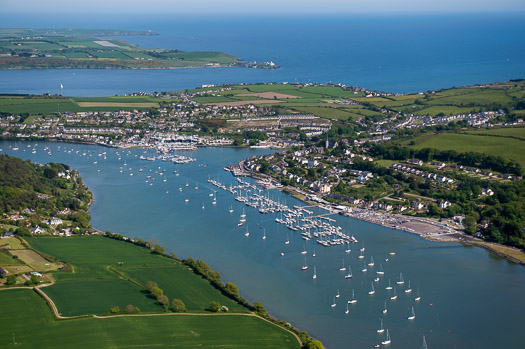 Crosshaven in the summer time. When we look at the natural advantages to be found here, it's little wonder that structured recreational sailing on Cork Harbour long-pre-dated any organised sport on Dublin Bay. Photo: Robert Bateman
Crosshaven in the summer time. When we look at the natural advantages to be found here, it's little wonder that structured recreational sailing on Cork Harbour long-pre-dated any organised sport on Dublin Bay. Photo: Robert Bateman
So you might well ask just just who do they think they are, these people from Dublin, going down to Cork to try to tell them how sailing should be organised? The nerve of them, doing it in a place where they've had organised sailing since 1720, and where the two biggest clubs – the Royal Cork and Kinsale – are both mighty establishments of international sailing repute which would remain so even were the ISA to disappear overnight in a puff of smoke...
And as for going west along the road to Galway, that will take them through Athlone where the Lough Ree Yacht Club dates back to 1770, while on the west coast the Royal Western of Ireland YC at Kilrush traces its origins back to 1828. Equally, further north along the Atlantic coast Sligo YC dates back to 1821, and in Lough Erne the club began in 1820. Yet the first club on Dublin Bay, the Royal Irish, only began as recently as 1831, and even then it barely hung in and had to be revived in 1846, with the pace being set in the meantime by the Royal St George YC, founded 1838.

Kinsale is another harbour which seems to have been designed with sailing primarily in mind. Photo: Kevin Dwyer/courtesy ICC

Kilrush on the Shannon Estuary had a club in being before there were any sailing institutions on Dublin Bay. Photo: W M Nixon
So in terms of sailing administration history, Dublin and Dun Laoghaire are only Johnny-come-lately places by comparison with just about everywhere else in Ireland. Yet thanks to the inevitable dominance of economic development, population growth and the strengthening centres of political power, we now find that sailing administration and decisions of national import are emanating from a place that, in terms of natural sailing advantages, lags far behind the rest of the country.
Oh for sure, Dun Laoghaire Harbour is a fabulous artificial amenity, and the advent of the new marina at Greystones has already been seized upon as greatly increasing the "cruising" options of Dublin Bay. But let's face it, Dublin Bay is really only good for racing, specific day sailing and training, whereas Cork Harbour and Kinsale provide such a variety of opportunities for interesting race courses, mini-cruises with multiple destinations and what have you, that in effect they're not just in a different part of the country – they're a different country altogether.

Dun Laoghaire is a totally artificial facility, and sailing options on Dublin Bay are limited. But it's inescapable that this is the primary point of leisure access to the sea for Ireland's largest and most affluent population. Photo: Kevin Dwyer/courtesy ICC
All of which adds to the difficulties of creating a meaningful national authority with which every sailing person can identify.
This business of Dublin v The Rest is not unique to sailing, of course, but when you have a specialist sport with multiple sub-branches of activity, the problem is exacerbated.
So please bear this in mind if you take yourself along to the meetings in Cork or Galway during the next ten days. This really is a genuine attempt to base the ISA within the sailing community at an everyday level of usefulness to all, with scope for growth while enhancing existing structures, and input from the sailing community at this stage will help in developing the ideas and initiatives proposed.
While the draft ISA Strategic Plan 2015-2020 very definitely puts the emphasis back on to the need for healthy well-run clubs as the basis for the sport, there was initially a feeling at the meeting on January 21st that the new-look ISA is not supportive of commercial sailing schools. In fact, what the new-look ISA hopes to do is encourage training schemes within clubs, while at the same time supporting commercial sailing schools where the demand is such that no club could realistically cope while maintaining its essential club ethos.
Going into this in more detail in a personal meeting this week with Neil Murphy, who is a Chartered Quantity Surveyor, we talked around the fact that a thriving club scene is central to the spirit of Irish sailing, and he was musing on the success of Sutton Dinghy Club where Hugh Gill heads up what is in effect a commercial sailing school within a club setting.
In fact, what Murphy would hope to see emerge at larger population centres is sailing's equivalent of the public golf course. Anyone who has used a public golf course will be aware that the proprietors are usually mustard keen to encourage the formation of a "club" within their customer base, and there is no reason why this shouldn't eventually take root in Irish sailing, providing access to sailing at a fraction of the cost of joining an established club.
It's not something which can realistically be objected to by established clubs trying to protect their own membership, as the people who would use a "public sailing club" would be those who simply couldn't afford to go sailing at all in the current traditional club setup.
Nevertheless support for the established club setup is central to the new Strategic Plan, and the provision of Regional Development Officers to serve clubs directly is very much to the fore in the new thinking. But in looking over the figures published with the report, it's good to note that the ISA works with no less than 80 recognised training centres, while an encouraging statistic is that there are now 24 secondary schools in Ireland which include sailing as a regular part of their curriculum. Admittedly it's a long way from the French setup where every schoolkid is entitled by law to one week of sailing and one week of skiing per year, but in a country where an aversion to being on the water used to be thought inevitable, it's a step in the right direction.
All these considerations of inexpensive sailing are a whole world away from the stories of recent weeks and days about the ISA's High Performance Division seeking a fund-raising executive who will be tasked with finding €2.75 million per annum through philanthropic and other donations in order to help the funding of top level campaigns which we're not allowed to call Olympic campaigns, as apparently that is copyrighted by the Olympic Council, so we call them High Performance instead.
But apparently Government departments aren't restricted by this limitation on the use of the word Olympic, for it was bandied about like nobody's business in this week's news that the government is spending mightily through the Sports Council, with sailing being number three in all Ireland in terms of current Sports Council funding, with a total tag of €1,289,900.
Of course it's not all for specifically Olympic sailing, but it covers 103 sailors from Optimists to the Olympics. Which is fine and dandy for those who are mad keen to race at the highest level, but most sailors in Ireland are much more interested in performing well within their chosen area and boat class, but with sailing being just part of a reasonably civilised and well-balanced life.
And as became evident at the meeting on January 21st, there's an increasing number of people who feel that sailing needs to realise that there's a sizeable population out there of folk who'd like to go sailing, but don't feel the almost religious vocation to own a boat.
With the rapid expansion of sunshine sailing holidays with boats and equipment readily available for hire at the destination, there's a strong feeling there's a real need for more of this in Ireland, even if we can't guarantee the sunshine. The suggestion brings us back to both the "public sailing club" concept, and the growing realisation by established clubs that they have to reach out to potential members by having boats available for sailing on a trial basis.

The Affordable Sailing Team – Norman Lee (right) with his brother Ken beside their campervan at last year's GP 14 Worlds at East Down YC on Strangford Lough. Photo: W M Nixon
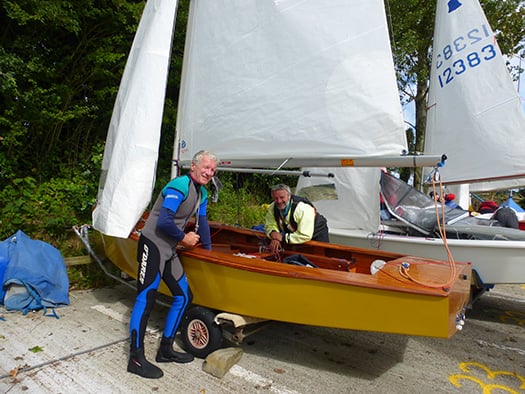
With their own very high can-do standards of boat maintenance, Norman and Ken Lee can keep their GP 14 in the competitive frame. Photo: W M Nixon
That said, the need to own one's own boat and tune and tinker with her to your heart's content is what sailing is all about for many of us, and Norman Lee is a classic case in point for this approach. He claims that his sailing costs him just €600 per year, though that of course is after he has paid for his well-tuned GP14, and he has long since written off the cost of the vintage camper-van which is home to the Lee Equipe when they hit the campaign trail.
Nevertheless the entire setup has to be outstandingly good value, and doing it in such economical style is part of the fun of it all. So when someone with Norman Lee's approach to sailing is prepared to get up at the big ISA public meeting in Dun Laoghaire and congratulate the team who have been working on the reforms which he and Bryan Armstrong set in train, then that is approval of a high order.
And as for just who or what is the ISA, can we maybe agree that ideally we all are the ISA, every last one of us who goes sailing or is even just interested in the sport, and it's up to us to keep it in line and encourage it to identify with and serve the ordinary sailor every bit as much as the high-flyer.

Private pleasure.....the 2014 GP 14 Worlds at East Down YC is about as high as many Irish sailors would expect or want to aim, and many are content with much lower-key regular club sailing. Photo: W M Nixon
Tributes Paid at SCORA AGM & Prizegiving Hosted By Royal Cork Yacht Club
#scora – The South Coast Offshore Racing Association (SCORA) AGM held at Royal Cork Yacht Club (RCYC) last Friday writes Claire Bateman.
A large and representative audience attended and the meeting was chaired by SCORA Commodore, Ronan Enright.
A minutes silence was observed to respect those members who had passed away during the year with special mention being made of the former very popular Class Commodore, Vinnie O'Shea who died during 2014.
Prior to going into the business of the evening, a special presentation was made to the Class Secretary, Jackie Kenefick, who was leaving the position Many tributes were paid to Jackie for all her efforts.
Having gone through the formal business of the meeting the floor was opened to the members and a discussion took place on the function of SCORA itself.
Cove Sailing Club's Commodore, Adrian Tyler, made a presentation on the new marina due to be open for the 2015 sailing season.
Following a break for refreshments the attendance had a brief discussion on Whitesail but the Commodore felt that as the Whitesail attendance would not be enough to represent the views of the Class, a further meeting would be called to discuss this item.
As there was no further business the meeting concluded with a slide show of the 2014 sailing season followed by the presentation of prizes.
Dinghy Fest 2015 – Royal Cork Yacht Club Launches Major Small Boat Racing Event for 2015
#dinghyfest2015 – The Royal Cork Yacht Club (RCYC) and more than seven Irish dinghy classes have launched a Cork Harbour Dinghy racing fesival for 2015. As Afloat.ie reported in October the 'Dinghyfest 2015' will consist of four days of 'world class' racing, with courses inside and outside Cork Harbour. Dinghy fest 2015 will run from 20th to the 23rd of August.
Irish class associations have confirmed that they will be holding the following events during the 4 day regatta:
• RS200 - Euro Cup & National Championships
• RS Feva National Championships
• RS 400 Southern Championships
• Mirror National Championships
• 420 Nationals Championships
• Topper Munster Championships
• National 18 Southern Championships
There will also be mixed dinghy racing as well as an Optimist championship.
Announcing the event, Nicholas O'Leary, 'Dinghyfest 2015' Director of Sailing said:
"I've been moniitoring the growth of dinghy sailing over the past number of years and believe the time is now right to get all fleets together and host a National Dinghy Festival. I'm delighted that we will be hosting Dinghyfest 2015 at the Royal Cork Yacht Club. Over the last year or so I've seen a lot of old competitors and good mates migrate back to our roots of the dinghy classes. Graduates of old from the social Intervarsity Team Racing Circuit are now picking up affordable dinghies like the RS's, Lasers and Mirrors to name but a few. The latest to get into the dinghy craze is Ireland's Figaro "Full Irish" Campaigner, David Kenefick, who will join over a dozen RS 400's now racing in Cork Harbour.
"There's a fair amount of dinghy sailors who want to get together to race hard and renew friendships forged in their youth sailing days. Expats further afield will hopefully come to the party and Dinghyfest 2015 will facilitate those sailors coming home to compete and hopefully bring sailors, from the UK and beyond , to enjoy what Cork Harbour has to offer. We have four race courses planned and will look at rotating classes to challenge the tactical skills of all, with the varying conditions which each race area will present."
Dinghyfest 2015 will encompass a number of Class Championships with two, three and four days racing planned depending on the requirements. An overall Dinghyfest Championships will combine results for three days racing from the 21st to the 23rd and the finer elements will be detailed within the NOR and SI's. Entries for all events will be through the dedicated RCYC website which will be live on 1st February.




























